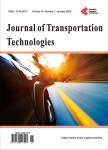Comparison of Estimated Cycle Split Failures from High-Resolution Controller Event and Connected Vehicle Trajectory Data
Comparison of Estimated Cycle Split Failures from High-Resolution Controller Event and Connected Vehicle Trajectory Data作者机构:Lyles School of Civil Engineering Purdue University West Lafayette USA
出 版 物:《Journal of Transportation Technologies》 (交通科技期刊(英文))
年 卷 期:2023年第13卷第4期
页 面:689-707页
学科分类:0809[工学-电子科学与技术(可授工学、理学学位)] 08[工学]
主 题:Split Failure Connected Vehicle Detector Traffic Signal Performance Measures Trajectory Data
摘 要:Current traffic signal split failure (SF) estimations derived from high-resolution controller event data rely on detector occupancy ratios and preset thresholds. The reliability of these techniques depends on the selected thresholds, detector lengths, and vehicle arrival patterns. Connected vehicle (CV) trajectory data can more definitively show when a vehicle split fails by evaluating the number of stops it experiences as it approaches an intersection, but it has limited market penetration. This paper compares cycle-by-cycle SF estimations from both high-resolution controller event data and CV trajectory data, and evaluates the effect of data aggregation on SF agreement between the two techniques. Results indicate that, in general, split failure events identified from CV data are likely to also be captured from high-resolution data, but split failure events identified from high-resolution data are less likely to be captured from CV data. This is due to the CV market penetration rate (MPR) of ~5% being too low to capture representative data for every controller cycle. However, data aggregation can increase the ratio in which CV data captures split failure events. For example, day-of-week data aggregation increased the percentage of split failures identified with high-resolution data that were also captured with CV data from 35% to 56%. It is recommended that aggregated CV data be used to estimate SF as it provides conservative and actionable results without the limitations of intersection and detector configuration. As the CV MPR increases, the accuracy of CV-based SF estimation will also improve.



